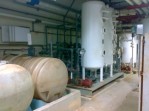De Mineralization water Treatment
Demineralization water treatment or de ionization water treatment process is the removal of essentially all inorganic salts by ion exchange. In this water treatment process, strong acid cation resin in the hydrogen form converts dissolved salts into their corresponding acids, and strong base anion resin in the hydroxide form removes these acids. Demineralization water treatment plant produces water similar in quality to distillation at a lower cost for most fresh waters. A demineralizer water treatment system consists of one or more ion exchange resin columns, which include a strong acid cation unit and a strong base anion unit. The cation resin exchanges hydrogen for the raw water cations as shown by the following reactions.

- Cation Resin Exchanges Hydrogen for the Raw Water Cations
Advantages of De mineralization water treatment are:
-
Demineralizers can produce high-purity water comparable to distilled water for nearly every use.
- Demineralized water is widely used for high-pressure boiler feed water and for many process waters.
- They come in a wide variety of sizes. Systems range from laboratory columns that produce only a few liters per hour to systems that produce thousands of liters per minute.


Limitations of De mineralization water treatment are:
-
Like other ion exchange systems, de mineralization require filtered water in order to function efficiently.
- Resin foulants and degrading agents, such as iron and chlorine, should be avoided or removed prior to de mineralization.
-
Anion resins are very susceptible to fouling and attack from the organic materials present in many surface water supplies.
- Some forms of silica, known as colloidal, or non-reactive, are not removed by a mineralization.
- Hot,alkaline boiler water dissolves the colloidal material, forming simple silicates that are similar to those that enter the boiler in a soluble form. As such, they can form deposits on tube surfaces and volatilize into the steam.
View Comments (3)
Deminaralized water treatment plant is informative.Explanation of resin is super.
The whole glance of your water treatment definition is fantastic and helpful in my examination.
fantastic guide for De mineralization of water . Stay the best!